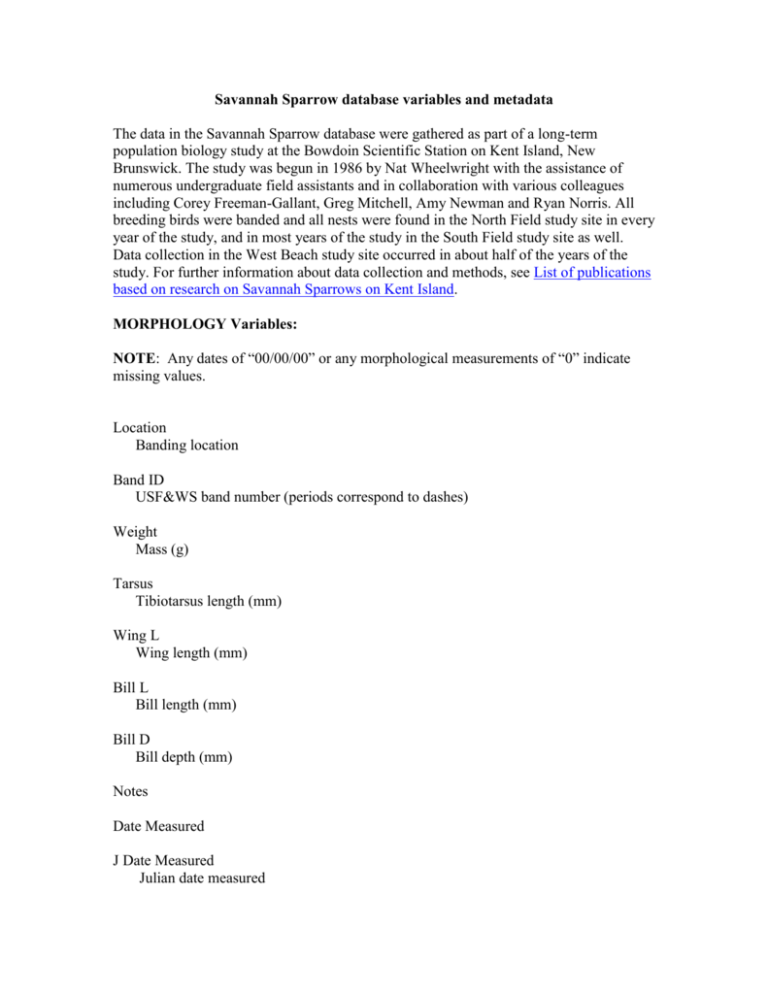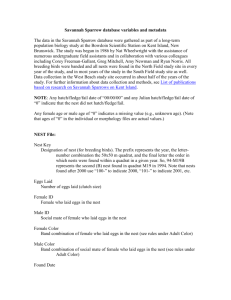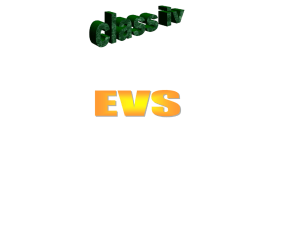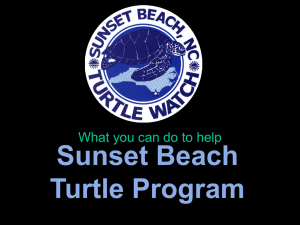Wheelwright SAVS Dryad 7_14.
advertisement

Savannah Sparrow database variables and metadata The data in the Savannah Sparrow database were gathered as part of a long-term population biology study at the Bowdoin Scientific Station on Kent Island, New Brunswick. The study was begun in 1986 by Nat Wheelwright with the assistance of numerous undergraduate field assistants and in collaboration with various colleagues including Corey Freeman-Gallant, Greg Mitchell, Amy Newman and Ryan Norris. All breeding birds were banded and all nests were found in the North Field study site in every year of the study, and in most years of the study in the South Field study site as well. Data collection in the West Beach study site occurred in about half of the years of the study. For further information about data collection and methods, see List of publications based on research on Savannah Sparrows on Kent Island. MORPHOLOGY Variables: NOTE: Any dates of “00/00/00” or any morphological measurements of “0” indicate missing values. Location Banding location Band ID USF&WS band number (periods correspond to dashes) Weight Mass (g) Tarsus Tibiotarsus length (mm) Wing L Wing length (mm) Bill L Bill length (mm) Bill D Bill depth (mm) Notes Date Measured J Date Measured Julian date measured Age in days Age in years Sex Color Color band combination (see rules under Adult Color) Year NEST Variables: NOTE: Any hatch/fledge/fail date of “00/00/00” and any Julian hatch/fledge/fail date of “0” indicate that the nest did not hatch/fledge/fail. Any female age or male age of “0” indicates a missing value (e.g., unknown age). (Note that ages of “0” in the individual or morphology files are actual values.) Nest Key Designation of nest (for breeding birds). The prefix represents the year, the letternumber combination the 50x50 m quadrat, and the final letter the order in which nests were found within a quadrat in a given year. So, 94-M19B represents the second (B) nest found in quadrat M19 in 1994. Note that nests found after 2000 use “100-” to indicate 2000, “101-” to indicate 2001, etc. Eggs Laid Number of eggs laid (clutch size) Female ID Female who laid eggs in the nest Male ID Social mate of female who laid eggs in the nest Female Color Band combination of female who laid eggs in the nest (see rules under Adult Color) Male Color Band combination of social mate of female who laid eggs in the nest (see rules under Adult Color) Found Date Date nest was discovered J Found Date Julian date nest was discovered J Lay Date Julian date first egg was laid Hatch Date Date first eggs hatched Julian Hatch Date Julian date first eggs hatched Eggs Hatched Number of eggs hatched Fledglings Number of nestlings that survived to 7 days of age Study Site S= South Field; N= North Field; WB= West Beach; O= other Orientation Compass orientation of nest entrance Cover Degree of cover over nest (O= open; 0.5= half-covered; C= completely covered; T= tunnel entrance to covered nest) Dist to Tree Distance (m) from nest to nearest tree Vegetation Predominant vegetation surrounding nest (G= grass; GO= goldenrod; V= viburnum; R= Rubus; H= miscellaneous herbs) Veg Ht Height (cm) of vegetation surrounding nest Fate Fate of nest (F= fledged at least 1; PE= preyed on at the egg stage; PN= preyed on at the nestling stage; AE= abandoned at the egg stage; AN= abandoned at the nestling stage) Mating Status Mating status of female (M= monogamous; P= polygynous) Female Number Rank of polygnously-mated female (1= alpha; 2= beta) Clutch Number 1= first; 2= second; R1= replacement of first; RR1= replacement of replacement of first; E= estimated X coordinate Last four digits of GPS X coordinate Y coordinate Last four digits of GPS Y coordinate Fail Date Date nest failed (except for nests with fate of “F”) J Fail Date Julian date nest failed Female Age In years Male Age In years Gull Dens Relative density (0 to 3) of gull nests in quadrat Incest Indication of high coefficient of relatedness (r> 0.25) between female and her social mate IncestEPP Indication of high coefficient of relatedness (r> 0.25) between female and her genetic mate (2002-2004 only) Percent EPP Percent of nestlings resulting from extra-pair fertilizations (2002-2004 only) Number of EPP sires (2002-2004 only) NoSameMatePrevious Number of previous nests with the same social mate BroodSexRatio (2002-2004 only) INDIVIDUAL Variables: Band ID USF&WS band number (periods correspond to dashes) Adult Color All adults have four bands (three plastic colored bands plus an aluminum USF&WS band). Almost all nestlings and fledglings have two bands (one plastic band plus an aluminum USF&WS band). We mainly use seven colors whose abbreviations are as follows: N (navy blue); R (red); B (black); L (light blue); S (striped black and white); Y (yellow); W (white). [There are a few combinations with dark green (G), light green (E), orange (O), or purple (P).] Bands are read from the bird’s left to its right, and from top to bottom. Example: a bird with a light blue band over a yellow on its left leg, and red over aluminum on its right would be “LY.R”; the aluminum band is always on the bottom (left or right leg), so in this example the single color “—.R” implies that the fourth band is the aluminum band, beneath the red one, on the right leg. For a nestling, the combination “W.” would be white on the left, aluminum on the right. Sex Banding Age N = nestling; J= juvenile; AHY= after hatching year Birth Year On the basis of strong breeding philopatry and primary feather shape, birds banded as AHY are assumed to have been born the previous year. Mother ID USF&WS band number of mother Father ID USF&WS band number of social father Genetic Father Band USF&WS band number of genetic father (2002-4 only) Mother Color Adult Color of mother Father Color Adult Color of social father Genetic Father Color Adult Color of genetic father (2002-4 only) Min Age at Deat Lifespan (last year seen minus birth year) Natal Nest Key Designation of natal nest (for birds banded as nestlings). The prefix represents the year, the letter-number combination the 50x50 m quadrat, and the final letter the order in which nests were found within a quadrat in a given year. So, 94M19B represents the second (B) nest found in quadrat M19 in 1994. Note that nests found after 2000 use “100-” to indicate 2000, “101-” to indicate 2001, etc. Natal Nest Site Study site of natal nest (S= South Field; N= North Field; WB= West Beach; O= other) Nest Area Study site of first breeding attempt as an adult (S= South Field; N= North Field; WB= West Beach; O= other) Day8_WL Wing length (mm) at 7-days of age Day8_Wt Mass (g) at 7-days of age Day8_TL Tibiotarsus length (mm) at 7-days of age Yr1 WL Wing length (mm) as a yearling Yr1 Tarsus Tibiotarsus length (mm) as a yearling Yr1 WT Mass (g) as a yearling Yr1 BL Bill length (mm) as a yearling Yr1 BD Bill depth (mm) as a yearling LifetimeUniqueMates Total mates over a lifetime Total Nests Total nests built over a lifetime Total Eggs Total eggs laid over a lifetime Total Nestlings Total eggs hatched over a lifetime Total Fledglings Total nestlings that survived to 7 days over a lifetime Total Recruits Total offspring that returned to breed on Kent Island Esex Estimated sex (based on wing length and mass, for birds sexed as juveniles) EPP Extra-pair offspring (2002-4 only) Notes









